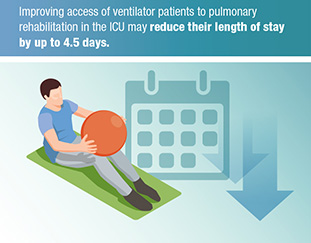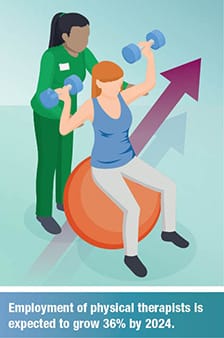
[ad_1]
Research demonstrates the value of rehabilitation for high acuity patients; however, not all patients receive this important care. Many patients coming out of the ICU need more time to recover in an acute-care setting for a full recovery. These post-intensive care patients can benefit from continued acute-level care paired with specialized rehabilitation therapies.
This whitepaper illustrates how such care can benefit patients in the form of improved outcomes; and providers, in the form of fewer readmissions.
Proven Benefits of Rehabilitation for High-Acuity Patients
Post-intensive care patients can face a series of new or worsening impairments of physical, mental, and cognitive health during their hospitalization.1 Fortunately, rehabilitation therapy has been shown to alleviate many of these symptoms and lead to fewer complications. Studies also show that the sooner rehab begins, the better the outcomes for patients who are coming out of the ICU.
There is well-documented evidence that rehab for high-acuity patients improves a variety of clinical factors:
- Early rehabilitation has been found to reduce complications associated with PICS.1
- In ICU patients, early rehab can help shorten the time patients spend on ventilators and in the ICU.2
- Improving access of ventilator patients to pulmonary rehabilitation in the ICU may reduce their length of stay by up to 4.5 days and shorten their time on ventilation by 2.3 days.3
- Rehabilitation and early mobilization are linked with increased walking ability, functional capacity and muscle strength.4
- Patients who have gone through rehab rate their quality of life better in terms of health.4
- Rehabilitation leads to improved recovery and better overall outcomes in a number of specific critical conditions: stroke, burn, traumatic brain injury, spinal cord injury and more.5
All of these findings suggest one conclusion – that rehabilitation should be an integral component of care plans for seriously ill patients throughout their hospitalization journey. To that end, when transitioning patients from one acute-care setting to the next, it is important to understand the types of rehabilitation offered at the facility to which these patients are discharging.
Case Studies: How Rehab in Post-Acute Care Benefits Short-Term Care Providers
Rehabilitation for high-acuity patients not only leads to better outcomes – it can result in considerable financial advantages for providers, particularly in terms of reductions in lengths of stay and financial loss minimization, as seen in the examples below.
- Johns Hopkins Hospital Medical ICU reported that implementing an ICU early rehabilitation program resulted in stay length reductions of 19-22%.6 This generated net cost savings of $817,836.
- As cited earlier, improving patient access to rehab consultations and therapies was found to reduce stay lengths by as many as 3.1 days.3
- This length-of-stay reduction saves providers significant operating costs: more patients are able to be treated when former patients do not need to return, and reimbursement denials are far fewer.
To reap the benefits of shorter lengths of stays, better discharge conditions and fewer hospital readmissions, understanding which post-acute care hospitals offer excellent rehabilitation programs is essential.
New Opportunities in Rehab Care
As the importance of rehab gains more recognition from a clinical benefits perspective, a number of other trends are signaling its expansion. A boom in rehabilitation innovations is one of the most visible.
Groundbreaking new technologies are emerging at a rapid pace, all of which significantly impact the effectiveness and efficiency of rehab therapies. These include brain and muscle stimulation devices, “smart” fabrics that track patient movement, sensor-augmented exoskeletons and even deep learning systems that track patient recovery progress.
Another trend indicating the growth of rehab is the increasing demand for physical therapists and other rehab professionals. According to the Bureau of Labor Statistics, employment of physical therapists is expected to grow 36% by 2024.7

The demand outlook also remains strong as America’s aging population is projected to experience more chronic and critical diseases.8
Further, the number of people who experience stroke is expected to rise by 21% by 2030, while the population of those aged 85+ is expected to increase by 123% by 2040. This data continues to indicate that the need for rehab has never been greater, with such an increase in medically complex patient population.
These demographics and new care possibilities present opportunities for acute and post-acute care providers to use rehab therapies, particularly those with advanced technologies and innovative programs, to meet the needs of increasingly ill patients.
How Kindred Hospitals Offers Enhanced Patient Outcomes Through Rehab
To help patients regain function and safely return home as quickly as their recovery allows, we specialize in treating post-ICU and medically complex patients who require continued intensive care and specialized rehabilitation in an acute hospital setting.
Because we are focused on treating this unique patient population and have over 30 years of expertise in doing so across the country, we are unique in our capability to provide the specialized care and customized rehabilitation designed to help a patient recover to the fullest extent possible.
Our patients benefit from rehabilitation provided by skilled and experienced clinicians, including physical, occupational and speech therapists. We provide specialized assessments and innovative therapy interventions, as well as individualized treatment based on the patient’s abilities and goals.
For a full look at our wide array of clinical rehabilitation therapies, check out more detail on our programs for specific conditions here.
To learn more about how Kindred Hospitals can help you achieve enhanced outcomes for your critical patients, Contact Us.
References:
- Parker AM, et al. Early Rehabilitation in the Intensive Care Unit: Preventing Impairment of Physical and Mental Health. Current Physical Medicine and Rehabilitation Reports. Dec 2013.
- Get Moving: Johns Hopkins Research Shows Early Mobility Better Than Bed Rest for ICU Patients. Johns Hopkins Medicine. Oct 2008.
- Carollo C, et al. Rehabilitation for People with COVID-19 in ICU. University of Padua. May 2020.
- Jang, MH et al. Pulmonary and Physical Rehabilitation in Critically Ill Patients. Acute and Critical Care Journal, vol. 34,1. Feb 2019.
- Schretzman Mortimer D, et al. Rehabilitation of Patients in Critical Care Settings. PM&R KnowledgeNow. Oct 2015.
- Lord RK, et al. ICU Early Physical Rehabilitation Programs: Financial Modeling of Cost Savings*. Critical Care Medicine. Mar 2013.
- About Physical Therapist (PT) Careers. American Physical Therapy Association. Mar 2019.
- Garza A. The Aging Population: The Increasing Effects on Healthcare. Pharmacy Times. Jan 2016.
July 15, 2019
[ad_2]
Source link
